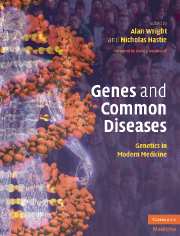Book contents
- Frontmatter
- Contents
- List of Contributors
- Foreword
- Section 1 Introductory Principles
- Section 2 Common Medical Disorders
- 13 Developmental disorders
- 14 Genes, environment and cancer
- 15 The polygenic basis of breast cancer
- 16 TP53: A master gene in normal and tumor suppression
- 17 Genetics of colorectal cancer
- 18 Genetics of autoimmune disease
- 19 Susceptibility to infectious diseases
- 20 Inflammatory bowel diseases
- 21 Genetic anemias
- 22 Genetics of chronic disease: obesity
- 23 Type 2 diabetes mellitus
- 24 Genetics of coronary heart disease
- 25 Genetics of hypertension
- 26 Obstructive pulmonary disease
- 27 Skeletal disorders
- 28 The genetics of common skin diseases
- 29 Molecular genetics of Alzheimer's disease and other adult-onset dementias
- 30 Major psychiatric disorders in adult life
- 31 Speech and language disorders
- 32 Common forms of visual handicap
- 33 Genetic and environmental influences on hearing impairment
- 34 Pharmacogenomics: clinical applications
- Index
- References
34 - Pharmacogenomics: clinical applications
Published online by Cambridge University Press: 17 August 2009
- Frontmatter
- Contents
- List of Contributors
- Foreword
- Section 1 Introductory Principles
- Section 2 Common Medical Disorders
- 13 Developmental disorders
- 14 Genes, environment and cancer
- 15 The polygenic basis of breast cancer
- 16 TP53: A master gene in normal and tumor suppression
- 17 Genetics of colorectal cancer
- 18 Genetics of autoimmune disease
- 19 Susceptibility to infectious diseases
- 20 Inflammatory bowel diseases
- 21 Genetic anemias
- 22 Genetics of chronic disease: obesity
- 23 Type 2 diabetes mellitus
- 24 Genetics of coronary heart disease
- 25 Genetics of hypertension
- 26 Obstructive pulmonary disease
- 27 Skeletal disorders
- 28 The genetics of common skin diseases
- 29 Molecular genetics of Alzheimer's disease and other adult-onset dementias
- 30 Major psychiatric disorders in adult life
- 31 Speech and language disorders
- 32 Common forms of visual handicap
- 33 Genetic and environmental influences on hearing impairment
- 34 Pharmacogenomics: clinical applications
- Index
- References
Summary
Introduction
There is now a large body of evidence indicating that genetic factors can influence treatment response in a variety of human diseases. Pharmacogenetics, defined as the study of the genetic basis for individuality in response to drugs (Vogel, 1959) or use of genetic analysis to predict drug response, efficacy and toxicity (Roses, 2004) has seen an almost exponential rise in peer-reviewed publications in the last 10 years (Figure 34.1). The closely related field of pharmacogenomics can be defined as the use of genetic approaches in drug discovery and use and encompasses the study of all genes which may influence drug response although, as illustrated in Figure 34.1, the terms pharmacogenetics and pharmacogenomics are often used interchangeably.
Inter-individual differences in response to commonly prescribed drugs are increasingly recognized. Serious adverse drug reactions (ADRs) have been estimated to occur in more than 2 million patients/year in the USA and result in more than 100 000 fatalities; meta-analysis of a number of US-based prospective studies suggest that ADRs are the fourth leading cause of death, after heart disease, cancer and stroke (Lazarou et al., 1998). A recent UK-based prospective study reported that up to 6.5% of all hospital admissions in the UK are related to adverse drug reactions, with a projected annual cost to the National Health Service of £466 million (Pirmohamed et al., 2004).
Individuality in drug response can be both genetically and environmentally determined.
- Type
- Chapter
- Information
- Genes and Common DiseasesGenetics in Modern Medicine, pp. 516 - 528Publisher: Cambridge University PressPrint publication year: 2007

